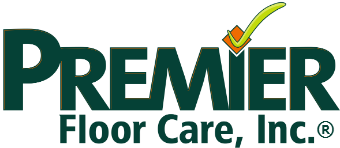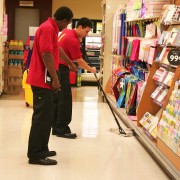Care and Maintenance of Vinyl Floors
Many people are unclear about whether vinyl and linoleum are the same type of flooring. They’re not. It also doesn’t help matters that the sales staff at some flooring retailers tend to use the terms interchangeably. What is true is that both vinyl and linoleum are “resilient,” and both can come on a sheet roll (or in tiles), but the similarity basically ends there. Vinyl and linoleum flooring are very different building products in nearly every respect including: material composition, application, installation and especially in their respective maintenance requirements.
So Is My Floor Vinyl Or Linoleum?
A common problem people have with vinyl versus linoleum flooring is how to tell the two apart. A quick and easy way to confirm whether your floor is vinyl or linoleum is to apply the “Paperclip Test.” Straighten a paperclip and heat the end with a lighter for approximately five seconds (use a pair of pliers to avoid burning your fingers). Press the heated metal tip firmly down on the floor covering for approximately three seconds. Slowly pull up the paperclip. You will notice a small hole in the floor if it is PVC. If it is linoleum the area around the hole will be slightly blackened (the charring is due to the fact that, unlike vinyl, linoleum contains natural materials like cork and wood flour).
Vinyl, aka Polyvinyl Chloride (PVC), flooring is tough and can stand up to high traffic. It is commonly used in commercial facilities like public offices, schools, and retail stores. Vinyl is resistant to scouring with antiseptic, antifungal, antiviral and antibacterial solutions which makes it a popular choice in hospitals. Vinyl also has good chemical resistance to oil, grease, and alcohols (spill on aisle 8) and very good chemical resistance to dilute acids, dilute alkalis, and aliphatic hydrocarbons (methane, ethane, propane, butane, etc.). Commercial grade vinyl (VCT) can withstand extremely high traffic, even light forklift traffic (with polyurethane wheels). For this reason VCT is becoming more popular in machine shops and industrial manufacturing facilities where it can provide a measure of damage tolerance superior to that of epoxy paint. In short vinyl is a floor of many talents.
Tough Not Indestructible
Concentrated point loads caused by heavy display cases with hard steel casters, work benches or furniture with narrow legs, or any heavy object with a small resting footprint can and will permanently indent the floor.
Tip: Replace all single-wheel metal casters with polyurethane double wheel casters to better distribute the weight of heavy equipment.
Vinyl and linoleum are both economic and both have roughly the same lifetime value. Vinyl flooring typically costs about one to two dollars per square foot and last for approximately ten to twenty years. Linoleum costs about twice as much but lasts for roughly twenty to forty years. Two drawbacks with linoleum versus vinyl is that linoleum will start to fade over time showing its age, whereas vinyl will maintain its appearance to the very end of its service life. Linoleum is susceptible to moisture damage—in wet or humid environments such as bathrooms it’s not uncommon to see the edges curl up from the tub and baseboard. Waterproof vinyl on the other hand is moisture, mildew and mold resistant and never loses its shape.
A broad catalog of vinyl flooring options can be found in nearly every home improvement center or building supply store. In addition to being one of the most durable, versatile flooring materials available, vinyl flooring comes in a virtually unlimited variety of colors and patterns (even custom printed patterns). It’s no surprise then that PVC flooring is very popular for both residential home use and commercial facilities. When properly maintained vinyl floors will last for many years. By following the recommended maintenance program, dirt and grime are removed before they can mar the floor finish or cause abrasions and tears. This not only increases the service life of the flooring, it contributes to a safe healthy environment by reducing hazards and improving cleanliness. Regular cleaning protects the floor, protects your investment, and gives your business or home an attractive appearance.
Vinyl Care Dos And Don’ts
Eco-Friendly Cleaning Tips
Eco-Footprint
At this time, PVC building products are not nearly as eco-friendly as linoleum. Unlike vinyl, linoleum is made from all natural, highly renewable resources. Linoleum can be recycled and in fact is biodegradable. Contrast this with vinyl flooring, for which nearly half the components are derived from hydrocarbons, a diminishing, non-renewable resource.
Despite the reliance on oil-based derivatives, most of vinyl’s carbon footprint doesn’t come from the hydrocarbons used to make it, but rather from the immense amount of energy needed to separate chlorine from salt. In fact, 57% of a typical vinyl floor is derived from ordinary table salt! The remaining 43% is derived from hydrocarbon feedstock. But the good news is this is changing fast. Manufacturers are increasingly turning to a PVC production process using ethylene from sugar crops as an alternative to ethylene from oil or natural gas. So in the future, when you walk down a grocery aisle, you could be walking on a floor made entirely from salt and sugar. And the energy used to make it may come entirely from solar, wind or another form of alternative energy. Upshot: a completely zero carbon-footprint building product.
Recycling technology has also come a long way in the last ten years. Whereas used PVC building products were once hauled to the landfill, there now exist so called “vinyl take-back” schemes like Recofloor which can mechanically recycle waste vinyl flooring and installation off-cuts with reasonable ease to produce good quality recycling material which can be used to make traffic cones, signage, flooring, and a number of other useful commercial products. Nevertheless, while efforts to find ways to recycle PVC products are expanding the technology at this time is still limited and mainly in the experimental stage.
Upcoming Blogs
- Care And Maintenance of Linoleum Floors
- Disaster Recovery: Earthquake, Water & Fire Damage




Follow Us